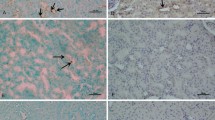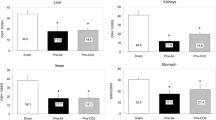Abstract
Backgrounds and aims
Laparoscopic surgery techniques have been increasingly preferred to classic laparotomy by surgeons since 1987. However, this method has some important adverse effects on intra-abdominal organs. The aim of this study is to evaluate the effects of different pressures of CO2 on apoptosis and p53 expression in cells in liver and spleen.
Methods
In total, 30 male Sprague–Dawley rats were used in the study. CO2 was insufflated into the intra-abdominal cavity via angiocatheter cannule by an insufflator in two different pressures of 10 and 20 mm Hg for 60 min. However, in the control group, only cannule was inserted into the intra-abdominal cavity, but no gas was insufflated. After 60 min, the rats were killed and laparotomy was applied. The liver and spleen were excised. The samples were histologically processed and immunohistochemistry was applied.
Results
All the data revealed that the number of apoptotic cells in liver and spleen increases in proportion to CO2 pressure level. No p53 expression was detected in both organs.
Conclusion
CO2 pressure level and application time may affect on cells living in liver and spleen. High pressure and/or long application time may cause releasing of cytokines and superoxide radicals from these organs’ cells, and transient or serious organ dysfunctions may occur.










Similar content being viewed by others
References
Davis CJ, Filipi CJ (1995) A history of endoscopic surgery. In: Arregui ME, Fitzgibbons RJ, Kotkhoude M, McKernan JB, Reich H (eds) Principles of laparoscopic surgery: basic and advanced techniques. Springer, New York, p 3
Rosario MTA, Ribeiro U Jr, Corbet CEP, Ozaki AC, Bresciani CC, Zilberstein B (2006) Does CO2 pneumoperitoneum alter the ultra-structure of the mesothelium? J Surg Res 133:84–88
Lindström P, Kallskog Ö, Wadström J, Persson AEG (2003) Blood flow distribution during elevated intraperitoneal pressure in the rat. Acta Physiol Scand 177:149–156
Erikoğlu M, Yol S, Avunduk MC, Erdemli E, Can A (2005) Electron microscopic alterations of the peritoneum after both cold and heated carbon dioxide pneumoperitoneum. J Surg Res 125:73–77
Sare M, Yılmaz I, Hamamcı D, Birincioğlu M, Özmen M, Yeşilada Ö (2000) The effect of carbon dioxide pneumoperitoneum on free radicals. Surg Endosc 14:649–652
Kopernik G, Avinoach E, Grossman Y, Levy R, Yulzari R, Rogachev B (1998) The effect of high partial pressure of carbon dioxide environment on metabolism and immune function of human peritoneal cells—relevance to carbon dioxide pneumoperitoneum. Am J Obstet Gynecol 179(6,1):1503–1509
Unsal MA, İmamoğlu M, Kadıoğlu M, Aydın S, Ulku C, Kesim M (2006) The acute alterations in biochemistry, morphology and contractility of rat-isolatd terminal ileum via increased intra-abdominal pressure. Pharm Res 53:135–141
Gutt CN, Kim ZG, Schmandra T, Paolucci V, Lorenz M (2000) Carbon dioxide pneumoperitoneum is associated with increased liver metastases in a rat model. Surgery 127(5):566–570
Schachtrupp A, Toens Ch, Hoer J, Klosterhalfen B, Lawong AG, Schumpelick VA (2002) 24 h pneumoperitoneum leads to multiple organ impairment in a porcine model. J Surg Res 106:37–45
Levine AJ (1997) p53, the cellular gatekeeper for growth and division. Cell 88:323–331
Tosun M, Kalkan S (2002) İntrauterin Dönemde Apoptosis’in Önemi. Sendrom 14(3):95–104
Helal MA, Mehmet H, Thomas NSB, Cox PM, Ralph DJ, Bajoria R, Chatterjee R (2002) Ontogeny of human fetal testicular apoptosis during first, second, and third trimesters of pregnancy. J Clin Endocrinol Metab 87:1189–1193
Tosun M, Kalkan S (2002) Apoptosis ve Önemi. Sendrom 14(6):120–126
Diebel LN, Dulchavsky SA, Brown WJ (1997) Splanchnic ischemia and bacterial translocation in the abdominal compartment syndrome. J Trauma 43:852–855
Andersson L, Lagerstrand L, Thorne A, Sollevi A, Brodin LA, Odeberg-Wernermann S (2002) Effect of CO2 pneumoperitoneum on ventilation–perfusion relationships during laparoscopic cholecystectomy. Acta Anaesthesiol Scand 46:552–560
Gründel K, Böhm B, Bauwenss K, Junghans T, Schebia R (1998) Influence of acute hemorrhage and pneumoperitoneum on hemodynamic and respiratory parameters. Surg Endosc 12:809–812
Acknowledgement
This study has been financed by Afyon Kocatepe University Scientific Research Projects Commission (approval no. 051-TIP-10).
Author information
Authors and Affiliations
Corresponding author
Rights and permissions
About this article
Cite this article
Arikan, Y., Tosun, M., Şaykol, V. et al. p53 expression and apoptosis in liver and spleen during CO2 pneumoperitoneum. Langenbecks Arch Surg 393, 877–882 (2008). https://doi.org/10.1007/s00423-007-0254-6
Received:
Accepted:
Published:
Issue Date:
DOI: https://doi.org/10.1007/s00423-007-0254-6




